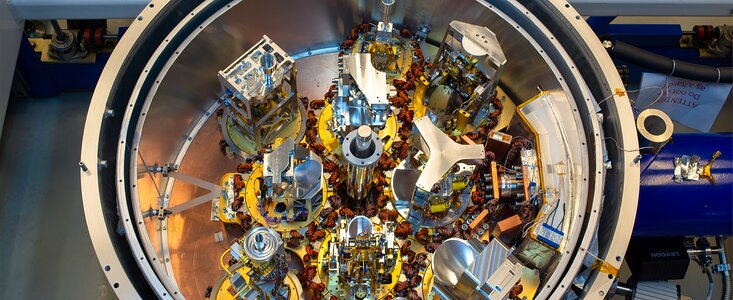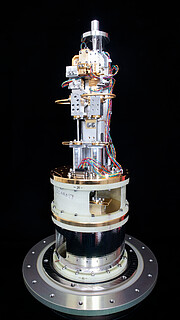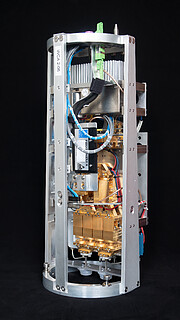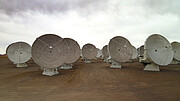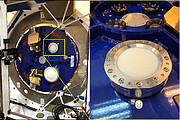Zprávy
New ALMA receivers that will probe our cosmic origins successfully tested
14. srpna 2023
An international team of astronomers and engineers at the Atacama Large Millimeter/submillimeter Array (ALMA), in which ESO is a partner, have made the first measurements using new receivers installed on multiple ALMA antennas. The receivers allow ALMA to observe within the final frequency range — with wavelengths between 2.6 to 4.5 millimetres (67-116 GHz) — for which it was designed. This so-called “Band 2” opens a new window into our cosmic origins, allowing measurements that reveal how distant stars and galaxies form, all the way down to the origins of planets and the building blocks of life.
ALMA, located on the Chajnantor Plateau in Chile, consists of a total of 66 antennas, each equipped with an arsenal of highly sensitive receivers. Each receiver type observes within a particular band, or range of wavelengths in the submillimetre/millimetre region of the electromagnetic spectrum. In total these bands cover a window from 0.3 to 8.6 millimetres (950 to 35 GHz; Bands 10 to 1, respectively). Band 2 opens a completely new window from 67-84 GHz, while expanding the bandwidth available in the 84-116 GHz frequency range, which is also covered by band 3.
The first Band 2 pre-production receiver was successfully installed and tested on an ALMA antenna earlier this year. Now, a second and third Band 2 pre-production receiver have been installed on two other ALMA antennas, enabling true interferometry: measuring the fringe pattern that results from the correlation of multiple signals from a bright astronomical object. This “first fringes” milestone means astronomers have been able to combine the signals from multiple antennas for the first time in Band 2. As further ALMA antennas are upgraded with Band 2 receivers, the amount of detail and level of sensitivity will improve, allowing for ever more precise observations of our Universe.
ALMA Band 2 will allow important measurements of the cold interstellar medium, the mixture of dust and molecular gas that exists in the space between stars and fuels star formation. As well as this, ALMA will be able to study the properties of dust and molecules in objects from planet-forming discs to far-away galaxies at a level of detail never achieved before.
Closer to home, the new receivers will enable observations of complex organic molecules in nearby galaxies, providing clues on how the conditions for life to begin are created. At the same time, Band 2 will be important for helping astronomers better understand how planets form by probing the carbon monoxide “snow line”, a region in planet-forming discs far away enough from the central stars for gas to condense.
The development of Band 2 was led by ESO and included partners at the National Astronomical Observatory of Japan (NAOJ), University of Chile, several European institutes and industry. Production of the first receiver cartridges was then carried out by a consortium comprising the Netherlands Research School for Astronomy (NOVA), the Advanced Receiver Development (GARD) group at the Onsala Space Observatory, Chalmers University, Sweden, and the Italian National Institute for Astrophysics (INAF), in collaboration with NAOJ.
Now, the team will work to optimise the performance of the pre-production receivers, and this will be followed by full production of the remaining receivers for installation on all 66 antennas, ushering in a new era of observations for ALMA. In concert with complementary ALMA upgrades planned for the 2030 time frame, the installation of Band 2 will enable an instantaneous bandwidth four times larger than what most current ALMA receivers can achieve, dramatically increasing its observation speed.
More Information
ALMA is a partnership of ESO (representing its member states), NSF (USA) and NINS (Japan), together with NRC (Canada), NSTC and ASIAA (Taiwan), and KASI (Republic of Korea), in cooperation with the Republic of Chile. The Joint ALMA Observatory is operated by ESO, AUI/NRAO and NAOJ.
Kontakty
Bárbara Ferreira
ESO Media Manager
Garching bei München, Germany
Tel: +49 89 3200 6670
Email: press@eso.org
O zprávě
| Id: | ann23013 |
Our use of Cookies
We use cookies that are essential for accessing our websites and using our services. We also use cookies to analyse, measure and improve our websites’ performance, to enable content sharing via social media and to display media content hosted on third-party platforms.
ESO Cookies Policy
The European Organisation for Astronomical Research in the Southern Hemisphere (ESO) is the pre-eminent intergovernmental science and technology organisation in astronomy. It carries out an ambitious programme focused on the design, construction and operation of powerful ground-based observing facilities for astronomy.
This Cookies Policy is intended to provide clarity by outlining the cookies used on the ESO public websites, their functions, the options you have for controlling them, and the ways you can contact us for additional details.
What are cookies?
Cookies are small pieces of data stored on your device by websites you visit. They serve various purposes, such as remembering login credentials and preferences and enhance your browsing experience.
Categories of cookies we use
Essential cookies (always active): These cookies are strictly necessary for the proper functioning of our website. Without these cookies, the website cannot operate correctly, and certain services, such as logging in or accessing secure areas, may not be available; because they are essential for the website’s operation, they cannot be disabled.
Functional Cookies: These cookies enhance your browsing experience by enabling additional features and personalization, such as remembering your preferences and settings. While not strictly necessary for the website to function, they improve usability and convenience; these cookies are only placed if you provide your consent.
Analytics cookies: These cookies collect information about how visitors interact with our website, such as which pages are visited most often and how users navigate the site. This data helps us improve website performance, optimize content, and enhance the user experience; these cookies are only placed if you provide your consent. We use the following analytics cookies.
Matomo Cookies:
This website uses Matomo (formerly Piwik), an open source software which enables the statistical analysis of website visits. Matomo uses cookies (text files) which are saved on your computer and which allow us to analyze how you use our website. The website user information generated by the cookies will only be saved on the servers of our IT Department. We use this information to analyze www.eso.org visits and to prepare reports on website activities. These data will not be disclosed to third parties.
On behalf of ESO, Matomo will use this information for the purpose of evaluating your use of the website, compiling reports on website activity and providing other services relating to website activity and internet usage.
Matomo cookies settings:
Additional Third-party cookies on ESO websites: some of our pages display content from external providers, e.g. YouTube.
Such third-party services are outside of ESO control and may, at any time, change their terms of service, use of cookies, etc.
YouTube: Some videos on the ESO website are embedded from ESO’s official YouTube channel. We have enabled YouTube’s privacy-enhanced mode, meaning that no cookies are set unless the user actively clicks on the video to play it. Additionally, in this mode, YouTube does not store any personally identifiable cookie data for embedded video playbacks. For more details, please refer to YouTube’s embedding videos information page.
Cookies can also be classified based on the following elements.
Regarding the domain, there are:
- First-party cookies, set by the website you are currently visiting. They are stored by the same domain that you are browsing and are used to enhance your experience on that site;
- Third-party cookies, set by a domain other than the one you are currently visiting.
As for their duration, cookies can be:
- Browser-session cookies, which are deleted when the user closes the browser;
- Stored cookies, which stay on the user's device for a predetermined period of time.
How to manage cookies
Cookie settings: You can modify your cookie choices for the ESO webpages at any time by clicking on the link Cookie settings at the bottom of any page.
In your browser: If you wish to delete cookies or instruct your browser to delete or block cookies by default, please visit the help pages of your browser:
Please be aware that if you delete or decline cookies, certain functionalities of our website may be not be available and your browsing experience may be affected.
You can set most browsers to prevent any cookies being placed on your device, but you may then have to manually adjust some preferences every time you visit a site/page. And some services and functionalities may not work properly at all (e.g. profile logging-in, shop check out).
Updates to the ESO Cookies Policy
The ESO Cookies Policy may be subject to future updates, which will be made available on this page.
Additional information
For any queries related to cookies, please contact: pdprATesoDOTorg.
As ESO public webpages are managed by our Department of Communication, your questions will be dealt with the support of the said Department.
